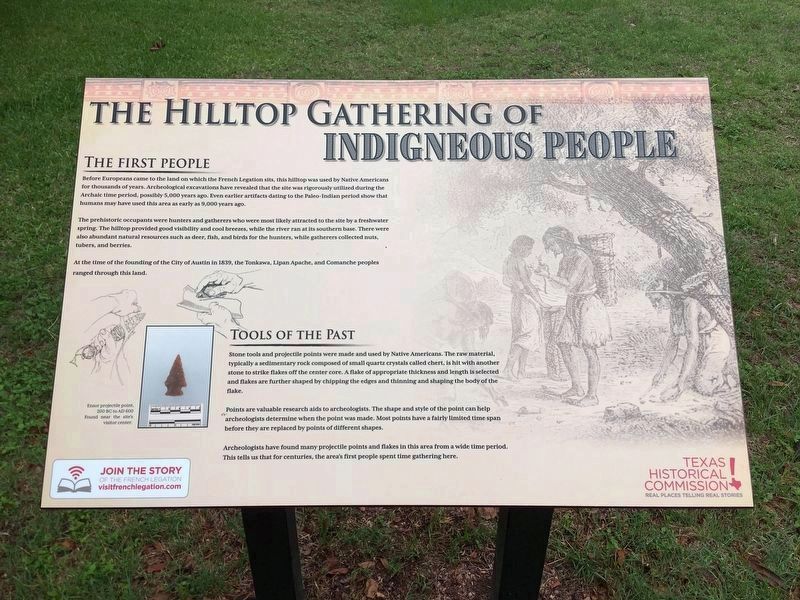Central East Austin in Travis County, Texas — The American South (West South Central)
The Hilltop Gathering of Indigenous People
Inscription.
The First People
Before Europeans came to the land on which the French Legation sits, this hilltop was used by Native Americans for thousands of years. Archeological excavations have revealed that the site was rigorously utilized during the Archaic time period, possibly 5,000 years ago. Even earlier artifacts dating to the Paleo-Indian period show that humans may have used this area as early as 9,000 years ago.
The prehistoric occupants were hunters and gatherers who were most likely attracted to the site by a freshwater spring. The hilltop provided good visibility and cool breezes, while the river ran at its southern base. There were also abundant natural resources such as deer, fish, and birds for the hunters, while gatherers collected nuts, tubers, and berries.
At the time of the founding of the City of Austin in 1839, the Tonkawa, Lipan Apache, and Comanche peoples ranged through this land.
Tools of the Past
Stone tools and projectile points were made and used by Native Americans. The raw material, typically a sedimentary rock composed of small quartz crystals called chert, is hit with another stone to strike flakes off the center core. A flake of appropriate thickness and length is selected and flakes are further shaped by chipping the edges and thinning and shaping the body of the flake. Points are valuable research aids to archeologists. The shape and style of the point can help archeologists determine when the point was made. Most points have a fairly limited time span before they are replaced by points of different shapes. Archeologists have found many projectile points and flakes in this area from a wide time period. This tells us that for centuries, the area's first people spent time gathering here.
Erected 2020 by Texas Historical Commission.
Topics. This historical marker is listed in this topic list: Native Americans.
Location. 30° 16.033′ N, 97° 43.933′ W. Marker is in Austin, Texas, in Travis County. It is in Central East Austin. Marker can be reached from the intersection of Embassy Drive and East 8th Street, on the right when traveling south. Marker is on the grounds of French Legation State Historic Site located on the west of visitor center. Touch for map. Marker is at or near this postal address: 802 San Marcos St, Austin TX 78702, United States of America. Touch for directions.
Other nearby markers. At least 8 other markers are within walking distance of this marker. French Legation (within shouting distance of this marker); French Embassy (within shouting distance of this marker); George A. Peterson House (about 600 feet away, measured in a direct line); Ebenezer (Third) Baptist Church (about 700 feet away); Metropolitan African Methodist Episcopal Church (approx. 0.2 miles away); Randerson-Lundell Building (approx. ¼ mile away); Victory Grill (approx. ¼ mile away); Stuart Female Seminary (approx. 0.3 miles away). Touch for a list and map of all markers in Austin.
Also see . . . French Legation, Texas. Wikipedia entry (Submitted on January 27, 2024, by Larry Gertner of New York, New York.)
Additional commentary.
1. Robertson Hill
The "hilltop" referenced here is known as Robertson Hill.
— Submitted June 26, 2022, by Richard Denney of Austin, Texas.
Credits. This page was last revised on January 27, 2024. It was originally submitted on June 26, 2022, by Richard Denney of Austin, Texas. This page has been viewed 155 times since then and 47 times this year. Photo 1. submitted on June 26, 2022, by Richard Denney of Austin, Texas. • J. J. Prats was the editor who published this page.
